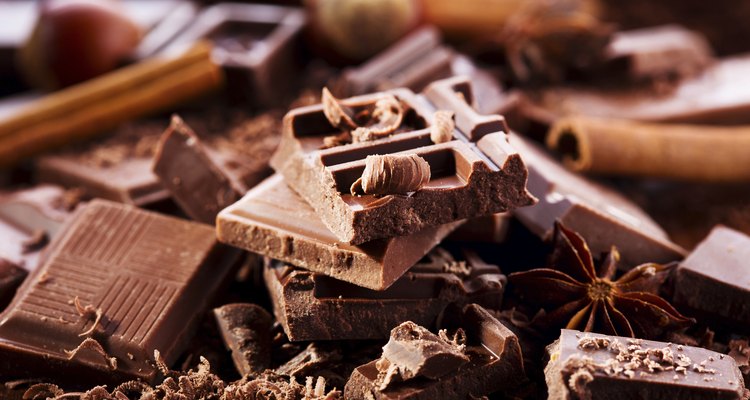
Nikolay Trubnikov/iStock/Getty Images
While chocolate is beloved all around the world, European and American chocolate varieties have some subtle differences in flavor and texture which seem to polarize chocolate-lovers. Generally, American chocolate is sweeter, while European chocolate is richer in cocoa. Manufacturers of some types of chocolate even use different formulations for chocolate sold in the U.S. and chocolate sold throughout Europe due to the regulations that differ here and abroad.
Cocoa Content
While both American and European chocolate are made with cacao beans, it's the amount of the cocoa solids in milk chocolate that differs. Chocolate in the U.S. is regulated by the U.S. Food and Drug Administration. The FDA mandates that American milk chocolate must contain at least 10 percent chocolate liquor, also known as cocoa solids, which is made from cacao beans. Semisweet and bittersweet American chocolate must contain at least 35 percent chocolate liquor. Chocolates made by European countries must adhere to the standards set by the European Union. The EU requires milk chocolate to contain at least 20 percent dry cocoa solids and darker chocolates to contain a minimum of 35 percent dry cocoa solids.
Texture
Because of its higher cocoa content, European chocolate is generally softer than its American counterparts. While the FDA doesn't allow chocolate manufacturers to include non-cocoa-based vegetable fats in chocolate, the EU does allow for the addition of vegetable fats, making it smoother and softer. American chocolate only contains cocoa butter, which is a bit harder than other vegetable fats. The temperatures across the U.S. are generally warmer than the countries in the EU, meaning that chocolate has to be more resistant to melting during transport. This is why American chocolate generally contains more solid fats and less chocolate liquor than European products, giving it more of a waxy texture.
Sweetness
Chocolate manufactured in the United States is generally sweeter than chocolate produced in European countries. This is mainly due to the fact that American chocolate contains less cocoa, which allows for the addition of more sugar or other carbohydrate sweeteners. European chocolate contains more cocoa and thus, less sugar. This is not true for some European brands marketed to the U.S., such as Cadbury, whose products differ in sugar content and other ingredients from products sold under the same name in Europe. American chocolate also contains sweeteners such as corn syrup, while European chocolate can only contain sugar. Corn syrup tends to have a sweeter flavor than sugar, which also accounts for the difference.
Bean Selection, Processing and Ingredient Variation
Today, different varieties of Theobroma cacao, the tree that produces cacao beans, are grown in South America, West Africa and Asia. While most chocolate produced in the U.S. comes from South America, much of the chocolate produced in Europe comes from West Africa, according to the BBC News Magazine. Both American and European chocolate contain emulsifiers such as lechithin, but other chemical additions may vary, depending on differences between the FDA and EU regulations. When it comes to milk chocolate, variations in dairy products produced in the U.S. and in European countries can affect the flavor of the chocolate. European milk chocolate varieties also tend to contain more milk, making them taste creamier.
Related Articles

Which Country Produces the Most ...

FDA Standards of Chocolate Identity

Difference Between Baking & Eating ...

How Many Types of Chocolate Are There?

Nutrition in Carob Vs. Chocolate
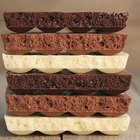
Foods Containing Theobromine

The Antioxidant Levels of Cacao

How to Melt Hershey's Chocolate
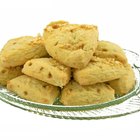
What Is the Difference Between Scones & ...

Sorbet Vs. Italian Ice

Swiss Chocolate Facts

How to Make Glaze for Donuts With Milk ...

The Difference Between Brown and White ...
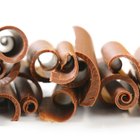
Cocoa Butter Nutrition

How to Make Chocolate Ganache With ...

What Is German Chocolate?

Can You Make Chocolate Ganache Frosting ...

Description & Characteristics of ...
Can I Substitute Neufchatel for Cream ...
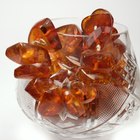
What Is Cognac Amber?
References
- BBC News Magazine: The Great Transatlantic Chocolate Divide
- U.S. Food and Drug Administration: CFR -- Code of Federal Regulations Title 21 -- Cacao Products
- Centre for the Promotion of Imports -- Ministry of Foreign Affairs: EU Legislation: Cocoa and Chocolate Products
- The New York Times: The World’s Best Candy Bars? English, of Course
- Library of Congress: Chocolate, Candy and the Law
- European Food Information Council: The Perfect Mixture: Emulsifiers Make Our Food Enjoyable
- LiveScience: What's the Difference Between Corn Syrup and Sugar?
- Daily Mail Online: Too Sweet, too Cheap and Full of Ghastly Chemicals -- Why Even Americans Can't Stand American Chocolate
Resources
Writer Bio
Based in Las Vegas, Susan Paretts has been writing since 1998. She writes about many subjects including pets, finances, crafts, food, home improvement, shopping and going green. Her articles, short stories and reviews have appeared on City National Bank's website and on The Noseprint. Paretts holds a Master of Professional Writing from the University of Southern California.
Photo Credits
Nikolay Trubnikov/iStock/Getty Images